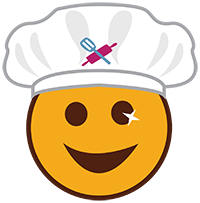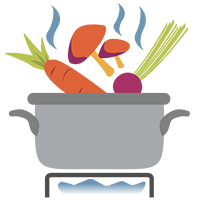Iconic Italian Sodas

Iconic Italian Sodas
Despite its name, Italian Soda originated in the United States, specifically in San Francisco. The once very popular drink was invented nearly a century ago by the Torre brothers—Italian immigrants who made and sold hand-crafted syrups like the one used in this recipe.
Happy & Healthy Cooking,
Fun-Da-Mentals Kitchen Skills
- stir :
to mix together two or more ingredients with a spoon or spatula, usually in a circle pattern, or figure eight, or in whatever direction you like!
Equipment Checklist
- Pitcher
- Dry measuring cups
- Liquid measuring cup
- Wooden spoon or spatula
Ingredients
Iconic Italian Sodas
- 1/2 C yogurt, vanilla or plain **(for DAIRY ALLERGY sub dairy-free/nut-free vanilla or plain yogurt)**
- 1/2 C granulated sugar
- 3 C sparkling water (use your favorite flavor)
- ice
Food Allergen Substitutions
Iconic Italian Sodas
- Dairy: Substitute dairy-free/nut-free vanilla or plain yogurt.
Instructions
Iconic Italian Sodas
combine + stir
In your pitcher, combine 1/2 cup yogurt and 1/2 cup sugar. Stir until the sugar is well mixed and mostly dissolved.
add + stir
Then, add 3 cups sparkling water and stir to create a bubbly Italian soda. Use your favorite flavor of sparkling water to spice up this drink! Pour over ice and enjoy!

Hi! I'm Yogurt!
"I'm a creamy and tangy food, and I'm very versatile! I work with both savory and sweet dishes. I also have less fat and more protein than sour cream, but you can often cook with me in the same way!"
History & Etymology
- Yogurt's origin is undetermined. The earliest yogurts may have been spontaneously fermented by bacteria on plants or milk-producing animals. Historians believe it may have emerged during the last Stone Age, sometime between 10,000 to 4,500 BCE, when the Neolithic people began domesticating animals.
- Ancient Grecians, Romans, and Persians ate a yogurt-like dairy product called "oxygala" (οξύγαλα). They would eat it with honey. These days people often eat plain yogurt with honey, especially Greek yogurt.
- Greek yogurt is strained, which eliminates the whey and other liquids, causing it to be thicker and have more tang than regular yogurt. It also has two times the amount of protein. It is called Greek-style yogurt if it is thickened by adding powdered milk or another dry thickener. People with lactose intolerance may have less trouble eating it.
- In 1916, Isaac Carasso of Barcelona introduced packaged yogurt to Europe. He dubbed it Danone, his son Daniel's nickname.
- Yogurt with added fruit jam was introduced in 1933 in Prague. Dannon, the North American subsidiary of Danone, produced a fruit-on-the-bottom yogurt in 1947.
- The word "yogurt" is from the early 17th century and is derived from the Turkish "yoğurt" (pronounced "yohght").
How Is it Made?
- Yogurt is a fermented dairy product made with milk. The bacteria used to ferment the milk is called the yogurt culture or starter. During fermentation, the lactose (the sugar in milk) is converted into lactic acid, which gives yogurt its tangy flavor and changes the milk protein, resulting in yogurt's texture.
- In various parts of the world, yogurt may be made from cow's milk, the most common source, or the milk of camels, goats, sheep, water buffalo, and yaks.
- Soy yogurt, a dairy-free alternative, is made from soy milk, which is not an animal product, as it is made from soybeans.
- Milk is first heated to about 185 degrees F to kill undesirable bacteria and alter the milk proteins so that they set together rather than form curds. The milk is then cooled to about 113 degrees F. Next, the bacteria culture or starter is added, and the temperature is kept at 86 to 113 degrees F for 6 to 12 hours to allow fermentation.
- If mold develops on the yogurt, toss it, as scraping off the top, visibly moldy layer does not entirely remove mold that has seeped into the rest of the yogurt.
How to Eat It
- You can eat plain yogurt by itself or with some honey or fruit. You can also buy yogurt that has already been sweetened and with fruit or fruit jam added.
- You can add plain yogurt to salad dressings, dips, sauces, and soups. It can add extra tang and richness to meat and poultry dishes in place of sour cream and brings tang and moisture to pancakes, cakes, and other baked goods. A fun way to eat fruit-flavored yogurt is in pies and frozen yogurt popsicles.
Nutrition
- Yogurt is rich in protein, vitamins B12 and riboflavin (B2), and the minerals phosphorus and calcium.
- Some studies found that eating 80 grams per day of low-fat yogurt was connected with a lower risk of developing type 2 diabetes and aiding bone health and digestion.
History of Italian Soda!

- Italian soda was developed in the United States, not Italy! It was first made by Torani, a San Francisco, California company, which makes flavored syrups.
- The founders, Rinaldo and Ezilda Torre were Italian immigrants who introduced their syrups to the San Francisco North Beach neighborhood in 1925. They created an Italian soda by mixing their syrups with sparkling water (also called carbonated or soda water).
- You can easily make an Italian soda at home with flavored syrup (typically fruit-flavored), sparkling water, and ice. If you add half-and-half or heavy cream to the concoction, it becomes a cremosa or Italian cream soda. The Italian word "cremoso" is "creamy" in English.
Let's Learn About Italy!

- Italy became a unified country in 1861, only 150 years ago. It is sometimes called "bel paese" or "beautiful country."
- Italians invented the piano and the thermometer!
- In ancient Roman mythology, two twin brothers named Romulus and Remus founded Rome, Italy's capital city. The myth says the twins were abandoned and then discovered by a she-wolf before being found and raised by a shepherd and his wife. Eventually (and after many exciting adventures), they found themselves at the location of Palatine Hill, where Romulus built "Roma." The Italian wolf became Italy's unofficial national animal.
- In the 1930s and 40s, Mussolini, Italy's prime minister, and dictator tried to eliminate all foreign words from the Italian language. How did he do that? He just changed them! For example, in soccer, "goal" became "meta." Disney character names changed, too: Donald Duck became "Paperino;" Mickey Mouse became "Topolino;" and Goofy became "Pippo." Although they're not banned anymore, these words and names have stuck. So now if you go to the Italian Disneyland, called Gardaland Park, you will see Topolino and Pippo!
- About 60 million people call Italy home, and it is 116,350 square miles, slightly larger than the US state of Arizona. If you compare that to the United Kingdom, 67 million people live there, and it is about 94,350 square miles. So, the UK is smaller than Italy but has a bigger population!
- The Italian flag is green, white, and red. These colors represent hope, faith, and charity.
- The average Italian eats close to 55 pounds of pasta annually. If you think about how light pasta is, that is a considerable amount! There are more than 500 different types of pasta eaten in Italy today.
What's It Like to Be a Kid in Italy?
- Kids begin school at 6 years old. They grow up speaking Italian, but they learn English in school, so many become bilingual in Italian and English.
- The most popular sport for kids is football (soccer). The Italian word for soccer is "calcio," the same word they use for "kick." A favorite of younger kids is "Rody, the bouncing horse," a plastic horse that a small child can hop onto and bounce around the room. Rody was invented in Italy in 1984.
- The family ("la famiglia") is a central characteristic of Italian life. Children have great respect for their older relatives. It is traditional to name the first male child after the grandfather and the first female child after the grandmother.
- If kids live close to school, they can go home and have lunch with their families! Lunch at school might be pasta, meat with vegetables, a sandwich, or a salad with lots of ingredients. Families typically eat dinner later (7 to 8 pm), so kids end up staying up later, too!
- Between lunch and dinner, kids often enjoy "merenda," which is an afternoon snack that translates to "something that is deserved." It is really a mini-meal that can include both savory and sweet foods. Examples of savory foods are a salami or mortadella sandwich, a slice of rustic bread rubbed with a cut, raw tomato, or "pizza bianca" (white pizza without tomato sauce). Types of sweet foods eaten during merenda are "gelato" (a lower-fat type of ice cream), any kind of cake, or biscotti dipped in warm milk.




